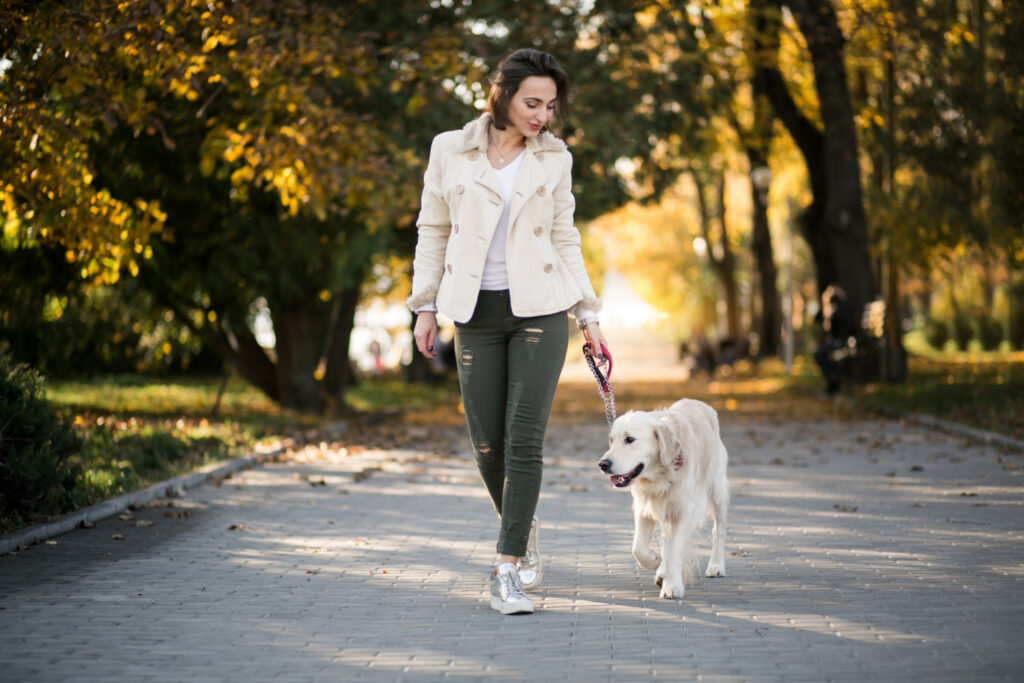Daily walks are essential for your dog’s well-being, providing essential exercise, mental health, and bonding time. However, without the right approach, even a short walk can turn into an ongoing challenge with pulling, jumping, or distractions.
Whether you’re guiding an energetic puppy or managing an adult dog with long-standing habits, the right strategies can change walks into calm, enjoyable experiences.
In this bolg, we’ll share tried-and-true Dog Walking Tips including effective training methods, must-have walking gear, behaviour-guiding and techniques for common challenges. Follow these tips to make every walk safer, smoother, and more rewarding for your dog.
Table of Contents
ToggleWhy Dog Walking Matters
Walking isn’t just about bathroom breaks. It’s a chance to bond, explore, and stimulate your dog’s senses. Dogs who walk regularly show reduced anxiety, better sleep, and improved obedience.
However, inconsistent walking routines or a lack of training can lead to leash pulling, barking at strangers, or even aggressive behaviour. This is where these Dog Walking Tips come in handy — giving you the tools to make walking a positive experience for both you and your pet.
Start with the Right Gear
Choosing the Right Leash and Collar
- Opt for a standard 4 to 6-foot leash. Avoid retractable leashes when training.
- A front-clip harness helps discourage pulling.
- Martingale collars are ideal for dogs that slip out of regular collars.
Comfortable Footwear for You
You’ll be walking daily — wear proper walking shoes to keep up with your dog comfortably. Having the right gear is the foundation of all successful Dog Walking Tips.
Before You Walk: Establish a Calm Mindset
Dogs often mirror your energy. If you’re tense or distracted, your dog may react similarly.
- Spend a few moments letting your dog calm down before putting on the leash.
- Only attach the leash once your dog sits calmly — never during jumping or barking.
This reinforces calm behaviour and sets the tone for a smoother walk.
Basic Leash Training: Build It Step by Step
1. Introduce the Leash Gradually
Let your pup wear the leash around the house for a few minutes a day so they associate it with safety and freedom, not restriction.
2. Practice Indoors First
Before heading outside, walk your dog around your living room or garden. Use treats and cues to reward calm behaviour.
3. Master “Heel” and “Let’s Go” Commands
Use positive reinforcement to teach your dog to walk beside you. When your dog pulls, stop walking. Only move again when the leash slackens.
These foundational steps are among the most effective Dog Walking Tips for new or untrained dogs.
Common Dog Walking Challenges & How to Fix Them
Pulling on the Leash
Dogs pull because it works — they get where they want to go faster. Break this cycle by stopping or changing direction every time your dog pulls. Consistency is key.
Reacting to Other Dogs or People
If your dog lunges or barks, create distance and redirect their attention with treats or commands. Socialisation exercises outside walk time also help.
Getting Distracted Easily
Bring high-value treats and practise focus commands like “Watch Me” to train your dog to pay attention during walks.
These Dog Walking Tips not only correct behaviour but also build better communication between you and your dog.
Stay Safe on Every Walk
Safety is a major component of dog walking. Consider the following:
- Walk during daylight or wear reflective gear at night.
- Keep your dog hydrated, especially in warm weather.
- Check their paws for debris or injuries post-walk.
Also, avoid letting your dog eat anything off the ground. Carry poop bags, and be respectful of others’ spaces and dogs. These small practices are powerful yet often overlooked Dog Walking Tips.

Mental Stimulation Is Just as Important
Incorporate Sniff Breaks
Let your dog sniff around occasionally. This stimulates their brain and prevents boredom.
Change Routes Frequently
New environments keep things exciting. Alternate parks, streets, or even directions to keep walks mentally enriching.
The best Dog Walking Tips aren’t just about control — they’re about fun, freedom, and enrichment.
Advanced Dog Walking Tips for Experienced Owners
If your dog already walks nicely, here’s how to take it up a notch:
- Use longer leads in open spaces to practise recall.
- Introduce backpack harnesses for mental and physical exertion.
- Practice “leave it” and “stay” in real-world settings.
Challenging your dog occasionally helps reinforce discipline while preventing stagnation.
Make Walks a Positive Routine
Create Consistency
Dogs thrive on routine. Walk at the same times each day to build predictability.
Reward Good Behaviour
Praise, treats, and affection should be constant companions on your walks. This will reinforce every lesson in these Dog Walking Tips.
Conclusion
Your dog’s daily walk is one of the most important activities of their day. It supports physical health, reduces stress, and strengthens your bond. With the right training, consistency, and mindset, you’ll see improvements in both your dog’s behaviour and your overall experience.
To recap, the most effective Dog Walking Tips include starting with the right gear, practising indoor leash drills, setting boundaries calmly, and keeping your dog mentally engaged throughout the walk. Every step you take is a chance to grow closer with your pup — so make it count.
The journey to better dog walking habits doesn’t happen overnight. But with patience, practice, and these practical Dog Walking Tips, you’ll soon be enjoying peaceful, productive strolls with your furry friend.







